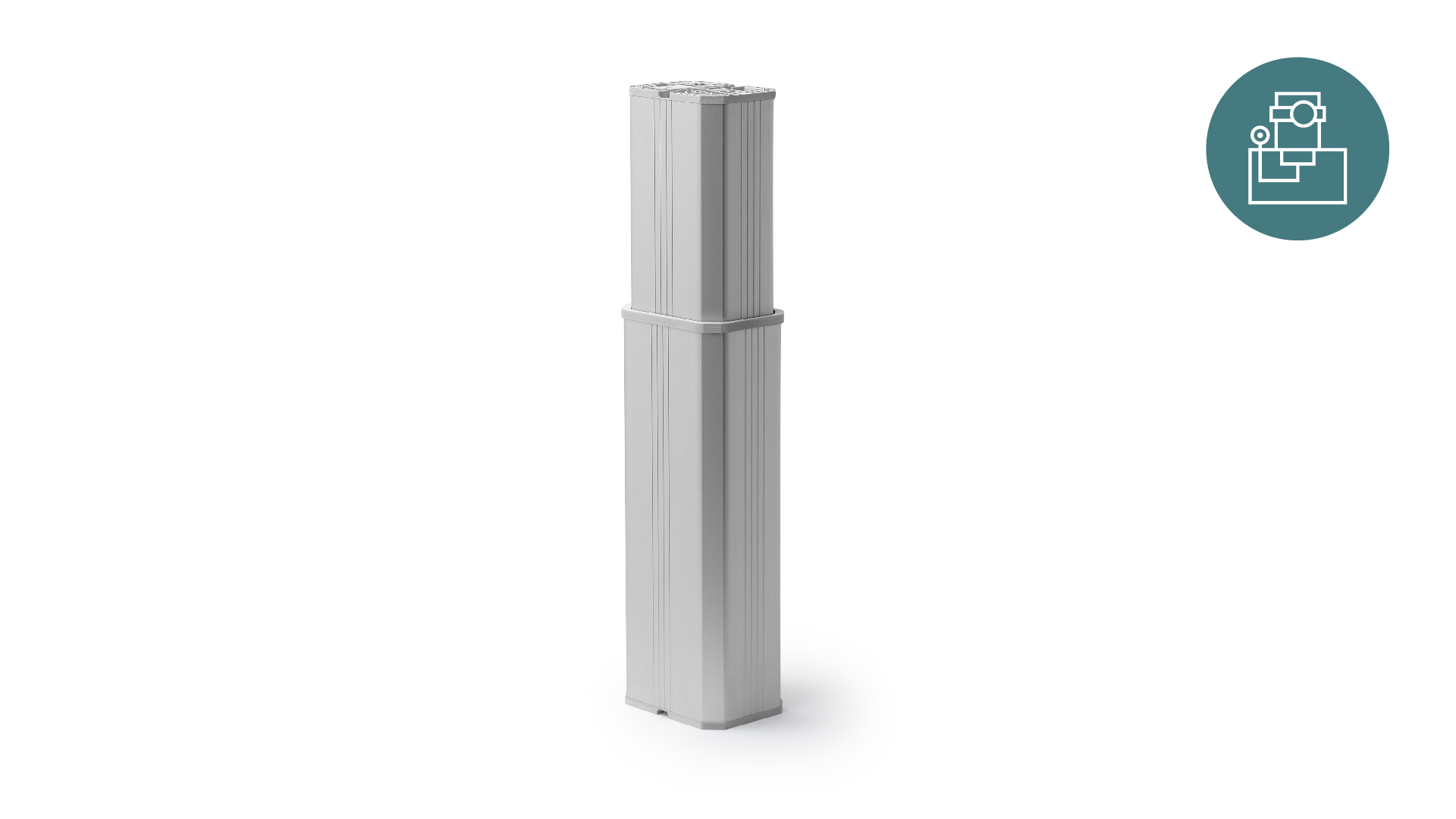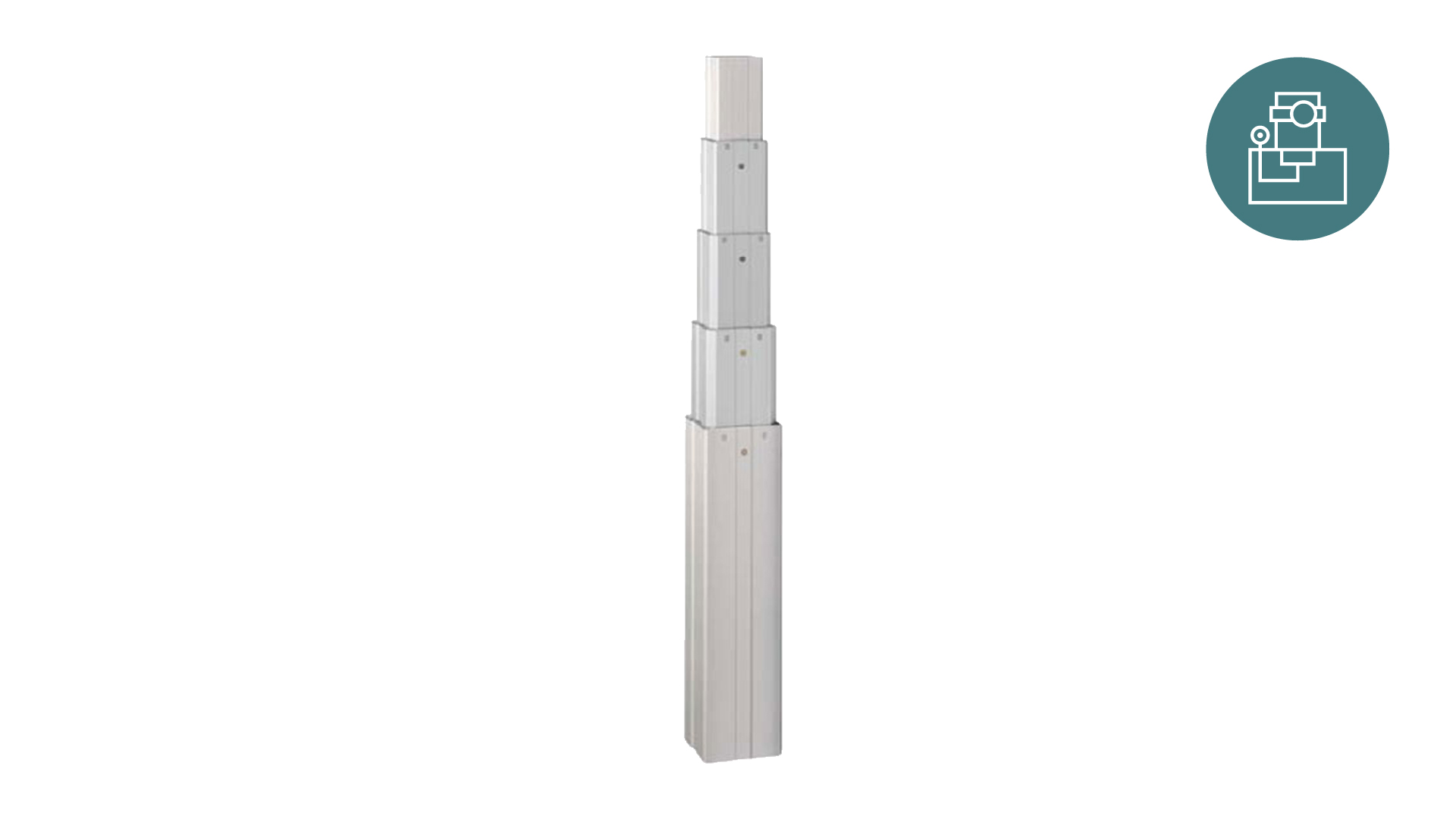Lifting columns (also known as telescopic pillars actuators or telescopic lifting columns) are a smart solution to implement a lifting function in industrial equipment. They are quiet, robust and powerful, and have an attractive design and satisfy the most demanding requirements.
In addition to these individual lifting column modules, we provide LIFTKIT lifting system for robots' seventh axis applications.
We offer a range of different telescopic lifting columns, in addition to various control units and operating switches. We also offer a customised lifting columns service which has enabled us to provide unique, client-specific solutions for a number of technical projects.
Lifting columns product range

CPMA
- Push load up to 2 kN
- Dynamic offset load up to 250 Nm
- Max. linear speed up to 15 mm/s
- Built-in universal power supply with soft start and stop control

CPMB
- Push load up to 2 kN
- Dynamic offset load up to 250 Nm
- Max. linear speed up to 15 mm/s
- Built-in universal power supply with soft start and stop control

CPMC
- Push load up to 4 kN
- Dynamic offset load up to 3 000 Nm
- Max. linear speed up to 25 mm/s
- High offset load capacity

CPMT
- Push load up to 6kN and pull up to 4 kN
- Dynamic offset load up to 1 400 Nm
- Max. linear speed up to 34 mm/s
- Low retracted height and high stroke range

TFG
- Push and pull load up to 2,5 kN
- Dynamic offset load up to 500 Nm
- Max. linear speed up to 15 mm/s
- Pull load capacity with fast movement

THG
- Push load up to 2 kN
- Dynamic offset load up to 1 000 Nm
- Max. linear speed up to 15 mm/s
- Slim and compact design

TLC
- Push and pull load up to 4 kN
- Dynamic offset load up to 2100 Nm
- Max. linear speed up to 11 mm/s
- Plug and play AC version

TLG
- Push load up to 4 kN
- Dynamic offset load up to 2800 Nm
- Max. linear speed up to 33 mm/s
- Rigid and stable, 2 or 3 sections

TLT
- Push load up to 5 kN
- Dynamic offset load up to 1 000 Nm
- Max. linear speed up to 42 mm/s
- Very small built-in size

TXG
- Push load up to 1,5 kN
- Dynamic offset load up to 210 Nm
- Max. linear speed up to 17 mm/s
- Aesthetic design with rounded shape

FRE
- Guiding aluminum tube system
- 2 or 3 sections available
- 7 square sections available
- Universal hollow guiding system

CPSM
- Max dynamic force 5 kN
- Max linear speed 100 mm/s
- High stiffness and high eccentric load
- Optional brake and dampening system

Control units for linear actuators
- Fitted with a 110 or 230 V AC or 24 V DC power supply
- 2, 3, 5 or 6 output channels 24 V DC, max. 18A, 30A for DC input
- Up to 3 control gear connections
- Rechargeable battery or removable rechargeable battery and wall charging station optional

Operating switches
- Up to 10 console switches
- DIN7, FCC or HD15 connectors
- Up to IP67
- Display for stored functions available as an option
Are you looking for a customised linear motion solution?
Find out how our customisation capabilities can meet your needs
Read more
Frequently asked questions
Lifting columns are telescopic devices designed to raise and lower applications efficiently and safely. These columns are commonly used in various industrial and automated applications, such as medical equipment, height-adjustable desks and manufacturing environments. Thanks to their flexibility and ease of use, lifting columns have become a valuable solution to enhance ergonomics and increase productivity across different industries. In summary, lifting columns provide ergonomic benefits, load-bearing capabilities, and enhanced safety, all while being versatile, durable, and easy to integrate into various applications.
Choosing the right lifting column depends on several key factors that align with the specific application and performance requirements. It is necessary to: assess the maximum weight of the load the column will be lifting, making sure it has adequate capacity; consider the physical dimensions and compatibility with the desired application; and check the technical specifications, such as lifting speed, bending load and maximum stroke, to ensure that they meet the needs of the project. Finally, check the build quality, materials used like anodized aluminum, and reliability of the lifting column manufacturer to ensure safe and durable operation.
Lifting columns differ mainly into electric and hydraulic, offering more precise control and greater load capacity, respectively. Two-stage and three-stage variants allow a wider vertical travel for specific applications. Choosing the ideal lifting column depends on specific speed, capacity and design requirements to achieve the most suitable lifting solution. Proposal: Lifting columns differ mainly into electric and hydraulic, where the electrical solution offers excellent precision and control over the movement. Two-stage and three-stage variants allow a wider vertical travel and higher bending moment capability for specific applications. Choosing the ideal lifting column depends on your specific needs in terms of speed, load capacity and design requirements to achieve the most suitable lifting solution.
Need more
information?
Ask our experts.
